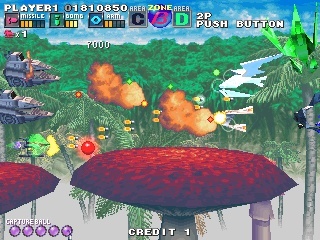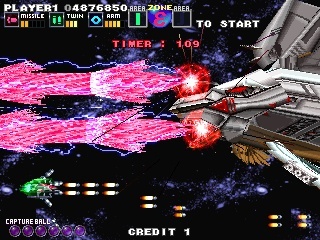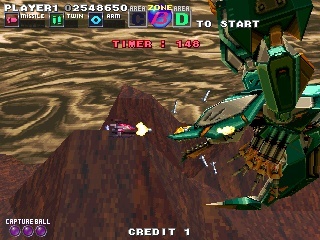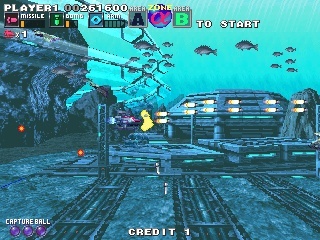G-Darius (Arcade) Review
By Gabriel Jones  19.03.2017
19.03.2017

In a battle that shook the pillars of existence, an entire planet was destroyed. This catastrophic upheaval of the galactic order caused long dormant being to awaken. Humans, once believed to be the apex of evolution, now face extinction at the fins of these creatures. The Amnelia Royal Cosmic Force, despite their best efforts, was hopelessly annihilated. However, they were able to collect some of the enemy's ancient and powerful technology. This incredible find led to the construction of an advanced fighter craft known as the "Silver Hawk." G-Darius is where it all began, the centuries of interplanetary conflict between the first and second most dominant lifeforms in the universe.
For some people, playing an STG is an almost spiritual experience. In the midst of chaos, where everything can be undone in an instant, the unimaginable stress gives way to something else. As is usually the case with the genre, a spacecraft faces an armada while surrounded by dozens if not hundreds of bullets. To not only survive but to also thrive in this nightmare can lead to someone reaching deep inside their self. What they uncover is a strength they never knew they had. If they can channel it, even for just thirty minutes, then they can accomplish what others believe to be insurmountable. Gamers might refer to this experience as entering "the zone."
Finding "the zone" is admittedly a pretty lonely endeavour. It requires a level of concentration and execution that is so precise that a gust of wind blowing across a blade of grass halfway across the world could break it. To share "the zone" with others is asking the impossible. The ideology behind G-Darius involves building a relationship capable of finding this mythical place, fleeting as it may be, or succumbing to a sea of bullets, whichever comes first. Unfortunately, this is no happy marriage. Like parasites, the best players feed off of the strongest organisms, and then discard them when necessary.

The previous entry in the Darius saga featured a gimmick known as the capture orb. With it, the Silver Hawk could take control of a mid-boss for a short while. In this sequel, the capture orb has evolved into an integral part of the game. At the beginning of every credit, the player is allowed three orbs, with opportunities to collect more as they progress. Orbs can capture practically any enemy, and they will make efforts to protect the parasite, with both their cannons and their hull. Only one ship can be captured at a time, so a second press of the button will cause the host to explode. This last ditch effort to protect the parasite that used them for so long makes for quite the strange relationship.
Naturally, the end of every area consists of a boss fight. These tyrants from a forgotten age are some of the most intimidating and difficult adversaries in the history of the series. After some time, these epic duels between incomparable forces climax with beam battles. Though the enemy battleship has more than enough energy to fire countless beams, the same can't be said for the Silver Hawk. In order to ensure the enemy's destruction, the parasite must have a host, whose energy is just enough to create a counter beam. What follows is an intense struggle for superiority, and the player can only win through a very severe amount of button mashing.

Relationships built on exploitation never last, but they're a necessity if the pilot has any expectations for survival. This game is merciless. The enemies are constant and unrelenting. The bosses crush hope, spirit, and ship into dust. Poor decision making will also spell a quick end for the Silver Hawk. Some captured enemies are practically useless, offering meagre assistance in the most crucial of moments. An ill-timed death can not only draw players out of "the zone," but they'll probably exhaust the rest of their lives just to regain their bearings. Every credit is a lesson in pain.
In spite of all this insanity, the difficulty never actually becomes cheap. Every death is as fair as a genre built on one-hit kills can be. It's still possible to collect power-ups such as stronger cannons and shields, and the brief respite offered by skilful capture use can increase survivability by a fair amount. The expectations of the player are simply higher than what previous Darius entries asked for. With the right amount of planning and an unbreakable will, the worst situations can be mitigated. Thanks to a great scoring system that revolves around intelligent usage of capture orbs, even people who manage to win without continues will find new avenues to challenge their exemplary abilities.
G-Darius is a very sad game. Early on, the realization hits that this is just the beginning of mankind's war with forces that they'll never understand. Sameluck Raida and Lutia Feen, the protagonists in this tragedy, could be considered star-crossed lovers. Their future is at the mercy of whichever final boss they manage to defeat. This entry carries on the tradition of having multiple endings. Even when it looks like the main characters will be together, it's only because existence itself is imploding, and they're seconds away from being lost to eternity. Talk about tough luck. Well, perhaps that's a glass half full interpretation. Maybe they somehow hit the universes' "reset button". Mankind gets a second chance, so hopefully they won't make the same mistakes. Then again, the altered timeline will probably result in Sameluck and Lutia never being born…

Hisayoshi "OGR" Ogura's soundtrack for this game is quite possibly the best work he's ever done. It's phenomenal. It encapsulates the depths of horror. Every track is the perfect blend of fear, hopelessness, and anger. These pilots, thrust into the unknown, aren't ready for the challenges that await them, but they must persevere. The astounding music adds so much to what is already a very involving and profound STG. The player really gets a sense that they're not just duelling to the death with a giant space fish, they're also caught in the internal battle, trying to dig past the uncertainties and improbabilities and reach "the zone."
With the FX-1B arcade hardware, Taito takes the series into a new dimension with stunning results. Rather than settle for a polygonal makeover, everyone went a few steps further to create an incredible atmosphere. As the Silver Hawk rockets through what may as well be a rollercoaster of sights and sounds, all of the familiar enemies are meticulously crafted to be at one with the environment. Even with everything happening on-screen, the player ship never gets lost in the scuffle. Clarity is essential in a shmup, and Taito handled the visuals with great care in order to achieve it.

Cubed3 Rating
Great - Silver Award

G-Darius isn't just a fantastic STG, it's also a work of art. Undoubtedly, the coupling of the words "videogame" and "art" are bound to cause retching for some, but it's hard to deny the genius on display here. In this genre, so many things happen all at once that settling on a single thought outside of "have to dodge these bullets" is an absurd proposition. That being said, this title makes players consider what's happening around them, as well as their purpose in a struggle that'll inevitably consume them.
Comments
Comments are currently disabled

 Sign In
Sign In Game Details
Game Details
 Out now
Out now  Out now
Out now  Out now
Out now  Out now
Out now  Subscribe to this topic
Subscribe to this topic Features
Features





 Top
Top

